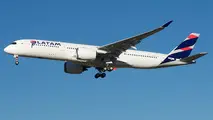LATAM Sees Excess Capacity In Colombia After JetSMART’s Launch
LATAM Airlines Group believes there is oversupply in Colombia’s domestic market after a new competitor launched operations earlier in 2024.

LATAM Airlines Group believes there is oversupply in Colombia’s domestic market after a new competitor launched operations earlier in 2024.
The Colombian franchise of South American ULCC group JetSMART debuted in March. Data from Aviation Week’s CAPA show the carrier has an 8% share of the country’s domestic seats.
“I would say the only market where we see today an imbalance that is visible between capacity and demand is Colombia,” LATAM’s new Chief Commercial Officer Ramiro Alfonsín said on an Aug. 8 earnings call. “Clearly the entrance of JetSMART to the market added a number of incremental flights that were not there a few months ago.”
As of early August, Colombia’s domestic seats were up 37% year-over-year, according to CAPA. Alfonsín said oversupply is a normal occurrence and “then the market kind of resets itself.”
Colombia was the only domestic market where LATAM lost share in the second quarter (Q2) compared with the year prior, dropping from 33% to 28%. Both LATAM Airlines Colombia and the country’s largest carrier Avianca expanded their domestic operations in 2023 after ULCC Viva ceased operations in February 2023.
LATAM’s management also fielded a question regarding a local Reuters report quoting LATAM Airlines Brazil Chief Executive Jerome Cadier saying the airline has mapped what growth could look like with a smaller capacity fleet, noting the aircraft could be sourced from Embraer or Airbus.
In response, the company’s executives said LATAM is always looking “at everything, not only aircraft, also engines ... [we] are looking at everything that we believe is an opportunity.”
In Embraer’s Aug. 8 Q2 results investor call, the Brazilian’s airframer’s CEO Francisco Gomes Neto said the company sees great opportunity to increase the E2’s presence in Brazil. The E-Jets are a “perfect fit” for that market, Gomes Neto said, adding that the type “can help airlines not only in Brazil but everywhere to add capacity quickly to their fleets.”
Brazilian airline Azul is one of the largest Embraer operators worldwide with 33 E195s and 16 E195-E2s in operation, according to the Aviation Week Network Fleet Discovery database. Azul’s fleet ranges from Cessna Caravans operated by its regional affiliate Azul Conecta to a mainline fleet of ATR-72s, the E-Jets, Airbus A320neos, A321neos and A330s. The airline is the only airline operating on 82% of is routes, and its domestic network encompasses 118 destinations, according to CAPA.
LATAM, meanwhile, doesn’t believe deliveries from Airbus will be significantly delayed, with executives noting the company feels very comfortable with its capacity plans for the remainder of the year. LATAM’s projections show its capacity will increase 14-16% year-over-year in 2024.
The company has some aircraft grounded due to issues with geared turbofan (GTF) engine powering A320neo family narrowbodies, but its management said the size of that subfleet is not significant. LATAM’s fleet plan shows it plans to end 2024 with 45 A320neo family aircraft. The company opted to keep some A319s longer than planned to compensate for the effects stemming from grounded aircraft with GTF engines.
LATAM’s overall fleet count at year-end, including cargo aircraft, will settle at 339 aircraft compared with 316 the year prior.
For Q2, LATAM posted a 13% year-over-year increase in operating revenue to $3 billion while expenses increased 14.6% to $2.8 billion. The airline’s Q2 net income increased to $145.3 million from $104.5 million the year prior.


